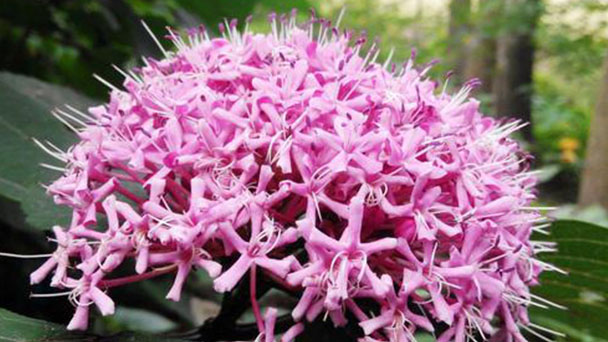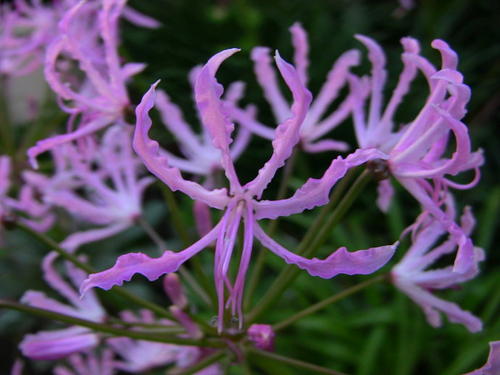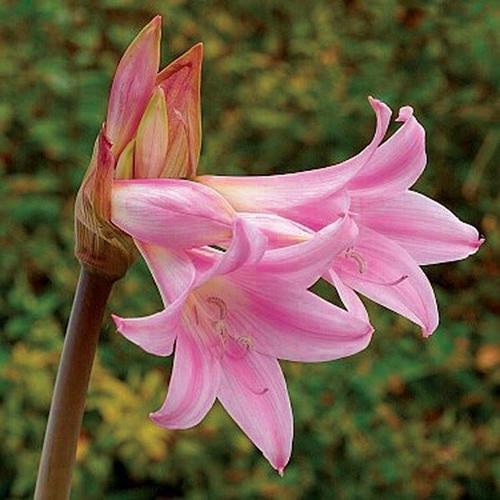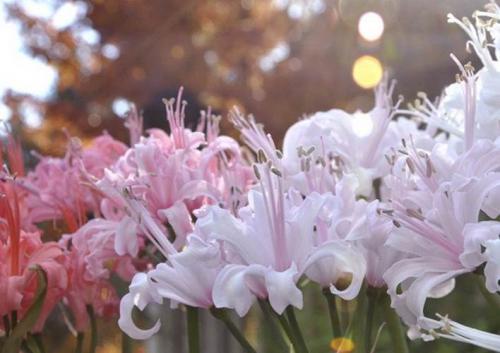Jersey lily (Nerine sarniensis) profile
Written by Maggie
Sep 11 2021

Jersey Lily (Nerine sarniensis), also called Amaryllis Lily, August Lily, Belladonna Lily, Jersey Lily, March Lily, Naked Lady, Resurrection Lily, is the genus Lycoris, native to South Africa. Jersey Lily prefers a warm, sunny environment and well-drained soil, not resistant to humidity and high temperature.
Jersey Lily plant is 20 to 50cm tall, with membranous bulbs. Basal, banding, leaves after anthesis. Umbel is at top of solid scapes. Scape is 60-75cm long, many flowered. Corolla pale is scarlet, funnelform, to 4.5cm long, lobes 6, slightly wrinkled, apex valgus.
Jersey Lily Picture

Jersey Lily Morphological Characteristics
Jersey Lily plant is 20 to 50cm tall, with membranous bulbs. Basal, banding, leaves after anthesis. Umbel is at top of solid scapes. Scape is 60-75cm long, many flowered. Corolla pale is scarlet, funnelform, to 4.5cm long, lobes 6, slightly wrinkled, apex valgus.
Jersey Lily leaves flowers 3 to 8cm in size. Stamens are bright red, straight out of the flower. The top of the stem has 10 to 20 flowers. Variety is very large, the flower shape is also rich in change. There are light orange, red, red and other varieties. Because its petals have metallic luster, the sun will shine, so also have diamond lily alias.
Jersey Lily Ecological Habits
Jersey Lily is semi-cold tolerant, prefers mild, sunny environment and well-drained soil, and cannot tolerate humidity and high temperature.
Jersey Lily is a cold-chamber spring flower plant. It is potted in August, and the potted soil must be rich in fiber. Do not have to turn the pot every year, leave the pot plants blooming well, early spring outdoor planting to cover the cold.
Where to Grow Jersey Lilies
Jersey lilies can be grown in the backyard in Britain however they don’t like in reality horrific moist winters so keep away from planting in frost pockets and uncovered areas.
Ideally plant Amaryllis belladonna in the safe haven of a heat wall, the place they will clump up nicely.
Jersey lilies seem to be excellent in gravel gardens and in borders however make certain they aren’t shaded by way of better flowers in the summertime when the dormant bulbs want to bake in the solar to bulk up strength and put on a correct exhibit in the autumn.
If you stay in a very bloodless section of the United states you might also want to develop them in pots or in glasshouses.
When to Grow Jersey Lilies
Plant Jersey lilies bulbs in spring for the plant life flower in the autumn.
How to Grow Jersey Lilies
Jersey lilies don't like being moist so if your soil is now not mild and fertile enhance drainage with the aid of digging in a lot of grit or you can plant the bulbs on the pinnacle of a mound of grit.
Plant the Jersey lilies bulbs simply under the soil or, in areas with terrible winters, plant at 4 or 5 inches deep to assist shield towards the cold.
How to Care for Jersey Lilies
Jersey Lilies want a warm and dry environment in the summer season. After the flowering period, mask the jersey lily plant with an accurate few inches of straw or comparable material in winter. Let the flora and foliage die down naturally. Feed with a handful of bonemeal to Jersey lily in spring.
How to Care for Potted Jersey Lilies
The key is to keep away from overwatering.
Water the vegetation extra as they come into growth, including a liquid feed, and preserve feeding and watering till the leaves begin to die.
Allow the plant life their hot, dry summer season baking.
Only repot when they are so congested that they don't flower so well.

Jersey Lily Propagation
The common propagation method of Jersey Lily is bulbous propagation. The seeds are fleshy and bulb-like, and the seeding seedlings are more variable. The methods of spheroidal propagation, seeding, base-cutting and tissue culture were mainly spheroidal propagation.
Division propagation
Remove the small bulbs of Jersey Lily around the big ball and plant them again. Breeding bulbs should not be harvested every year, generally separated by 3 ~ 4 years in the autumn selection of small bulbs without diseases and insect pests, good growth for potted or open cultivation.
In the scale-block base cutting method, the cleaned base of the bulb is cut into eight meters with a cutting depth of about 1/2 ~ 2/3 of the length of the bulb. Disinfected, dried in the shade, inserted into the matrix of wet sand, perlite, etc., after 3 months, scales and substrates
The adventitious buds of Jersey Lily can be seen at the junction, and the small bulbous bulbs are gradually produced. After separation and cultivation, seedlings can be formed.
Tissue culture propagation
Using MS medium, pedicels and ovaries as explants, callus could be produced at the incision. Adventitious roots of Jersey Lily can form after 1 month and adventitious buds can form after 3 to 4 months. Using pedicels and scales with stems as explants, adventitious buds and subforms can also be produced.
Sowing propagation
It is generally used only in cross breeding. Since seeds of Jersey Lily are not dormant, seeds should be sown immediately after seed collection, and radicals can be seen exposed after 15 days at 20℃. Natural environment seeding, the first growth cycle only a few seedlings pull out a leaf, the seedling stage can be transplanted once. It takes about 4 to 5 years from sowing to flowering.
Jersey Lily Disease Control
The management of diseases and insect pests of Jersey Lily is extensive, and common diseases include carbon blast and bacterial soft rot. Before planting, bulbs are soaked in 0.3% copper sulfate solution for 30 minutes, washed with water, and then planted after drying.Every half a month spray 50% carbendazim wettable powder 500 times liquid control.At the beginning of the disease, spray with 50% benzoite solution 2500 times.
The twittish nocturnal moth
Mainly with larva harm leaves, buds, fruits of Jersey Lily, gnaw mesophy, bite caries flowerscapes, seeds, generally at the end of spring to November time harm, available 5% raejin suspension agent 2500 times liquid, 1000 times liquid Wan Ling prevention and control.
Lycoris radiata the moth
When larvae invade the plant, the leaves are usually hollowed out and can directly eat the inside of the bulb. A large number of green or brown feces are usually left at the affected place. It is necessary to pay attention to whether there are neatly arranged eggs on the back of the Jersey Lily leaf, and immediately remove them if found. The prevention and control can be combined with the winter or early spring to dig out the overwintering insects pupae, reduce the insect population; When it happens, spray the insecticide Lexiborn 1500 times liquid or phoxim 800 times emulsion liquid, choose in the morning or evening when the larvae come out to take food spray, the prevention and control effect is better.
Thrips
The whole body is red, mainly in the bulb leaves to suck nutrition, resulting in the loss of Jersey Lily green leaves, especially after the fruit is found more mature, can use 25% imidacloprid 3000 times liquid, 70% Emmerol 6000 ~ 10000 times liquid rotation spray prevention.
Grubs
Underground pests have white grubs, found after the timely use of phoxim or trichlorfon and other drugs for control.
Jersey Lily Varieties
Jersey Lily has a wide variety of species and its flower shape is also varied. Jersey Lily has light orange, rose red, bright red and other varieties.
Jersey Lily's Distribution
Jersey Lily is native to Japan, southern Korea, eastern and southern China, northern Vietnam, northern Laos, northern Thailand, northern Myanmar, Nepal, northern Pakistan, Afghanistan and eastern Iran.
The role of Jersey lily
The bouquet
Jersey Lily can be used to wrap up different bouquets of flowers. Hybrids have become an important new type of cut winter and spring flowers. These bouquets can be given to relatives and friends as birthday gifts and holiday gifts.
Potted role
Jersey Lily can be used as a warm garden flower or pot plant.
Jersey Lily garden use
When Jersey Lily is cultivated in the garden green space, the general planting density is 15-20cm, row spacing 40m, and one row of other evergreen species is planted between the rows, that is, 12-16 balls are planted per square meter. In the configuration, if the red variety with smaller bulbs and lower price is used as the basic tone, it can be properly infused. This configuration can achieve the expected landscape effect after planting.

Latest Updated
- Benefits of Bugleweed - 7 Science-backed Health Benefits
- Bugleweed Dangers & Side Effects - Is It Poisonous?
- How to Plant Evergreen Trees - What You Should Know
- When to Plant Evergreens - Grow Guide for Evergreen Trees
- 12 Wonderful Evergreen Shrubs for Your Garden
- 12 Popular Evergreen Plants with Pictures for Beginners
- When And How To Prune A Lilac Bush Like a Pro
- How to Grow & Care for Lilac Vine (Hardenbergia Violacea)
- Japanese Lilac Tree (Syringa Reticulata) Care & Propagation Guide
- Shumard Oak Pros and Cons - What to Know
Popular Articles
- Winter maintenance of Antirrhinum Majus
- How to Grow Terminalia Mantaly Tree
- How to Grow and Care for Crossostephium Chinense
- How to grow Antirrhinum Majus in spring
- Peristeria Elata (Dove Orchid) Profile: Info & Care Guide
- Underwatered Snake Plant (Sansevieria Trifasciata) - Signs And How To Fix
- How to Care for Brazilian Jasmine Plant (Mandevilla Sanderi)
- How to Grow & Care for Graptopetalum Purple Delight in Summer
- Rosa Chinensis (China Rose): Plant Growing & Care Tips
- How to Care for Baby Sun Rose (Aptenia Cordifolia)